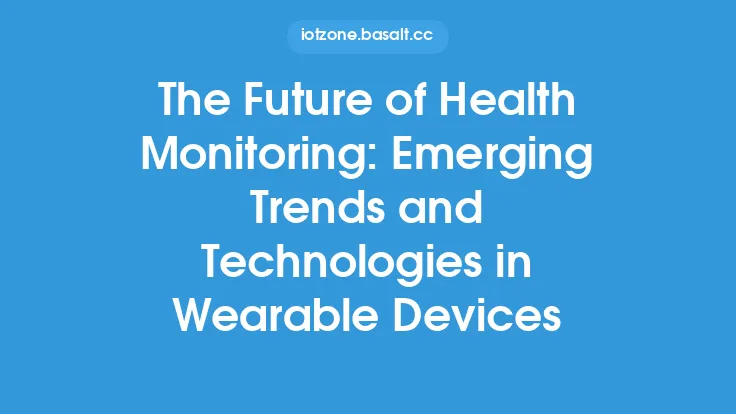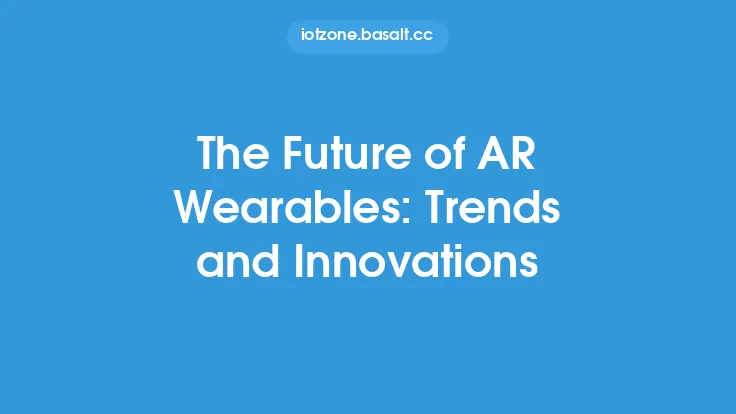The field of wearable sensors has experienced significant growth in recent years, driven by advancements in technology, decreasing costs, and increasing demand for personalized health and fitness tracking. As the industry continues to evolve, emerging trends and applications are expected to shape the future of wearable sensors. One of the key drivers of this growth is the development of new sensing technologies, such as electrocardiogram (ECG) and electromyogram (EMG) sensors, which enable the tracking of more complex physiological signals. These sensors have the potential to revolutionize the field of healthcare by providing real-time monitoring of vital signs and enabling early detection of diseases.
Emerging Trends in Wearable Sensors
Several emerging trends are expected to shape the future of wearable sensors. One of the most significant trends is the integration of artificial intelligence (AI) and machine learning (ML) algorithms into wearable devices. This enables the devices to analyze data in real-time, providing users with personalized insights and recommendations. Another trend is the development of wearable sensors that can track a wide range of physiological signals, such as blood pressure, blood glucose, and oxygen saturation. These sensors have the potential to revolutionize the field of healthcare by providing real-time monitoring of vital signs and enabling early detection of diseases. Additionally, the use of nanotechnology and flexible electronics is expected to enable the development of wearable sensors that are smaller, more comfortable, and more accurate.
Applications of Wearable Sensors
Wearable sensors have a wide range of applications, from healthcare and fitness to gaming and entertainment. In the field of healthcare, wearable sensors can be used to track vital signs, monitor chronic conditions, and enable early detection of diseases. For example, wearable ECG sensors can be used to detect arrhythmias and other heart conditions, while wearable EMG sensors can be used to track muscle activity and enable the control of prosthetic limbs. In the field of fitness, wearable sensors can be used to track physical activity, monitor progress, and provide personalized recommendations. For example, wearable accelerometers and gyroscopes can be used to track movement and provide feedback on form and technique. Additionally, wearable sensors can be used in gaming and entertainment to enable new forms of interaction and immersion.
Technical Advancements in Wearable Sensors
Several technical advancements are driving the development of wearable sensors. One of the most significant advancements is the development of new sensing technologies, such as piezoelectric and piezoresistive sensors, which enable the tracking of a wide range of physiological signals. Another advancement is the use of wireless communication protocols, such as Bluetooth and Wi-Fi, which enable the transmission of data from wearable devices to smartphones and other devices. Additionally, the development of energy harvesting technologies, such as solar and kinetic energy harvesting, is expected to enable the development of wearable sensors that are powered by the user's body or environment. Furthermore, the use of advanced materials, such as graphene and nanocellulose, is expected to enable the development of wearable sensors that are more comfortable, more accurate, and more durable.
Challenges and Limitations of Wearable Sensors
Despite the many advantages of wearable sensors, there are several challenges and limitations that must be addressed. One of the most significant challenges is the issue of data accuracy and reliability. Wearable sensors are often subject to noise and interference, which can affect the accuracy of the data. Another challenge is the issue of data security and privacy. Wearable sensors often collect sensitive personal data, which must be protected from unauthorized access. Additionally, the use of wearable sensors raises several ethical concerns, such as the potential for invasion of privacy and the potential for bias in the data. Furthermore, the development of wearable sensors is often limited by the availability of funding and resources, which can affect the pace of innovation and the widespread adoption of these technologies.
Future Directions for Wearable Sensors
The future of wearable sensors is expected to be shaped by several emerging trends and applications. One of the most significant trends is the development of wearable sensors that can track a wide range of physiological signals, such as blood pressure, blood glucose, and oxygen saturation. Another trend is the integration of AI and ML algorithms into wearable devices, which enables the analysis of data in real-time and provides users with personalized insights and recommendations. Additionally, the use of nanotechnology and flexible electronics is expected to enable the development of wearable sensors that are smaller, more comfortable, and more accurate. Furthermore, the development of wearable sensors is expected to be driven by the increasing demand for personalized health and fitness tracking, as well as the growing need for remote patient monitoring and telemedicine. As the field of wearable sensors continues to evolve, it is expected to have a significant impact on the healthcare, fitness, and gaming industries, and to enable new forms of interaction and immersion.




